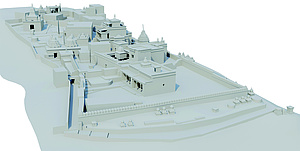Since 1999 several research projects have been carried out at Graz University of Technology on the topic “Buddhist Architecture in the Western Himalaya,” funded by the Austrian Science Fund (FWF). These projects concentrated on sacral architecture from the Guge-Purang Kingdom, which represented political and religious power in western Tibet between the tenth and fifteenth centuries. The continued endangerment of these important architectural monuments makes a continuation of the research activity vital. After compiling essential documentation in northern India and western Tibet, this project is now focusing on Nepal, especially the Dolpo region, in order to expand the existing research material.
Dolpo is region culturally influenced by Tibet and encompasses four valley situated in the territory bordering the Tibet Autonomous Region (China). More than 90 percent of this area is over 3,500 meters above sea level. Less than 5,000 people reside here, with Dolpo exhibiting the lowest population density of all Nepalese areas. The research project will be concentrated on the Nankhong Valley in northern Dolpo, since it is here that the oldest architectural structures remain.
In the scope of the planned field research, the idea is to first gather extensive documentation of the state of the various sacral buildings in this area. In a subsequent step, certain significant structures will be surveyed and documented with appropriate precision. The prepared material will then enable a detailed analysis of the architectural structures and show how different building types evolved in this region. This will lay a foundation for future building research and for the necessary restoration measures in Dolpo.
The results of this research project are also intended to illustrate the context-related correlations and features of Buddhist architecture in Nepal, northern India, and western Tibet. This represents another step in the establishment of a comprehensive typology of early Buddhist architecture in the western Himalaya.
Projectduration:
April 2018 – March 2021
Financing:
Austrian Science Fund (FWF)
Projectleader:
Institute of Architectural Theory, History of Art and Cultural Studies: Anselm Wagner, Birgit Androschin, Carmen Auer, Dieter Bauer; external expert: Holger Neuwirth

